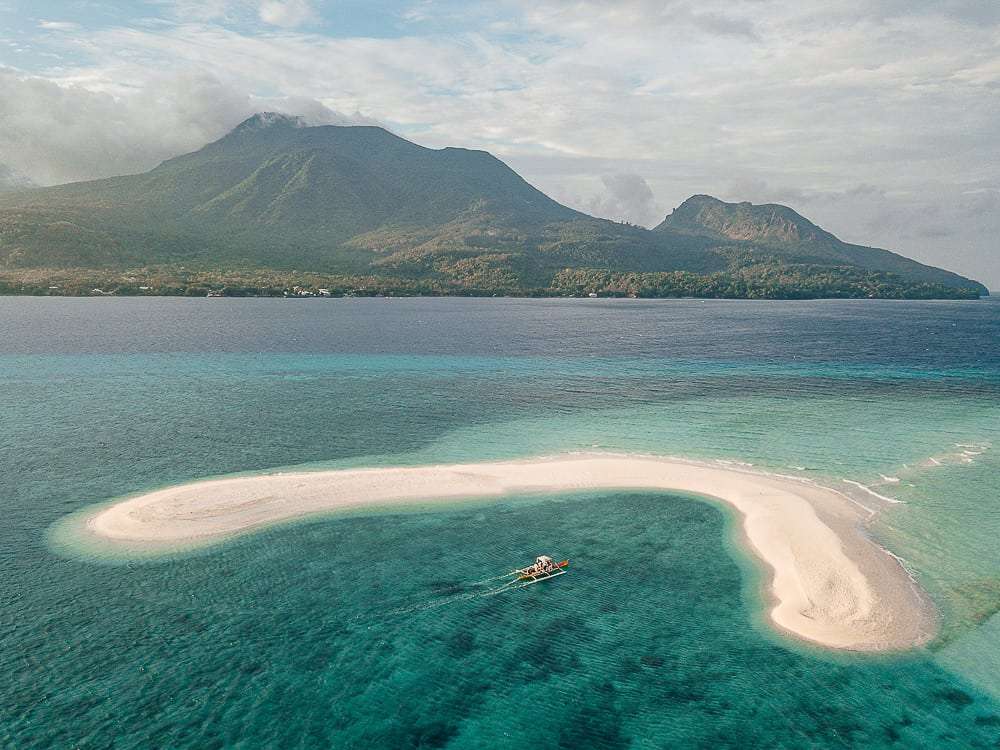

Camiguin, officially the Province of Camiguin, is an island province in the Philippines located in the Bohol Sea, about 10 kilometres (6.2 mi) off the northern coast of Mindanao. It is geographically part of Region X, the Northern Mindanao Region of the country and formerly a part of Misamis Oriental province.
Camiguin is the second-smallest province in the country in both population and land area after Batanes. The provincial capital is Mambajao, which is also the province's largest municipality in both area and population.
The province is famous for its sweet lanzones, to which its annual Lanzones Festival is dedicated and celebrated every third weekend of October. It is home to lush interior forest reserves, collectively known as the Mount Hibok-Hibok Protected Landscape, which has been declared by all Southeast Asian nations as an ASEAN Heritage Park. The province also boasts three National Cultural Treasures, namely, the Old Bonbon Church ruins in Catarman, the Sunken Cemetery of Catarman, and the Spanish-era watchtower in Guinsiliban. The three sites were declared for “possessing outstanding historical, cultural, artistic and/or scientific value which is highly significant and important to the country and nation.”
Additionally, the island province has numerous Important Cultural Treasures, such as the Old Mambajao Fountain - situated in the town's rotonda, the Old Mambajao Municipal Building, the façade of the Santo Rosario Church in Sagay, and 14 heritage and ancestral houses. The sites were declared for “having exceptional cultural, artistic and historical significance to the Philippines.” All cultural treasures were declared by the National Commission for Culture and the Arts. There have been moves to establish a dossier nomination for the province to be included in the UNESCO World Heritage List.
The name Camiguin is derived from the native word Kamagong, a species of ebony tree that thrives near Lake Mainit in the province of Surigao del Norte, the region from which the earlier inhabitants of the islands, the Manobos, originated. Kamigin, the local dialect of Camiguin, is the northernmost variant of the Manobo languages.
An earlier Spanish geography book spells the island as Camiguing. There is reason to suppose the Spaniards dropped the final g, given how the phoneme /ŋ/ does not exist in Spanish. Today it is rendered as Camiguín.
The island of Camiguin is believed to have been first inhabited by the Manobo people of Surigao del Norte, as evidenced by the distinctly connected language between the two groups. The island was used as a trading stop point by various merchants and traders from the Rajahnate of Butuan, the Kedatuan of Dapitan, the ancient people of the Anda peninsula, and possibly the Rajahnate of Cebu and the animist Maranao of Lanao before the Islamization of the Lanao provinces.
Old Spanish documents indicate that the renowned explorers Ferdinand Magellan and Miguel Lopez de Legaspi landed in Camiguin in 1521 and 1565, respectively. The first Spanish settlement was established in 1598 in what is now Guinsiliban. Guinsiliban, which comes from the old Kinamiguin word Ginsil-ipan (which means “to look out for pirates from a watchtower”) has an old Spanish watchtower where the Camiguinons kept watch for Moro pirates.
The first major Spanish settlement, established in 1679, was called Katagman or Katadman (known as Catarman). The settlement grew and prospered but was destroyed by the eruption of Mt. Vulcan in 1871. The former location is what is now Barangay Bonbon of Catarman.
Sagay, located south of Catarman, was formally established as a town in 1848. The word Sagay is derived from the name of poisonous fruit trees that grow in the area. Mambajao became a town in 1855. The name was coined from the Visayan terms mamahaw, meaning to usher breakfast, and bajao, which is leftover boiled rice. In the early 1900s, Mambajao prospered and became the busiest port in Northern Mindanao. Mahinog was established as a municipality in 1860. The name Mahinog comes from a Visayan word meaning "to ripen" or "to become ripe". Although Guinsiliban was the oldest settlement in the island, it was only in 1950 that it became a municipality. Mahinog was formerly governed by Mambajao while Guinsiliban was formally governed from Sagay.
In 1901, in the middle of the Philippine–American War, American soldiers landed in Camiguin to assume political control over the island. A group of Camiguinons, armed with bolos and spears, led by Valero Camaro, fought them in a short battle in Catarman. Valero Camaro was killed by a bullet in the forehead.
On June 18, 1942, the Japanese Imperial Army landed in Camiguin and set up a government in Mambajao. They gutted central Mambajao in reprisal to guerrilla activities in the area. The remains of some of these buildings still exist today.